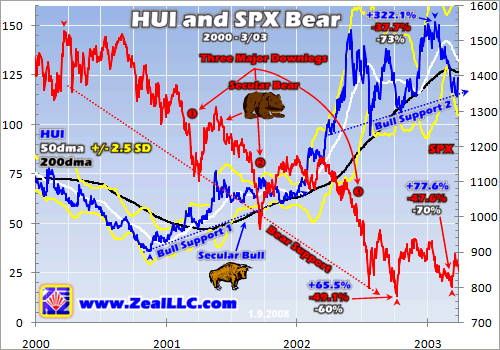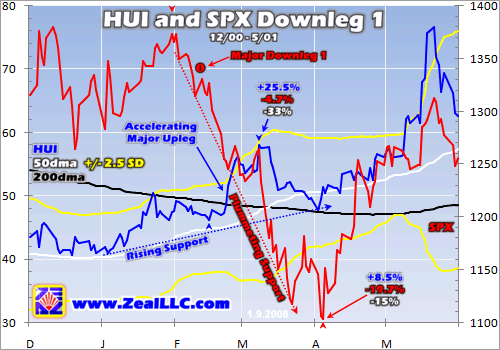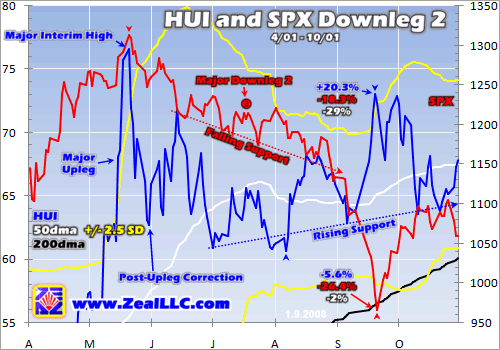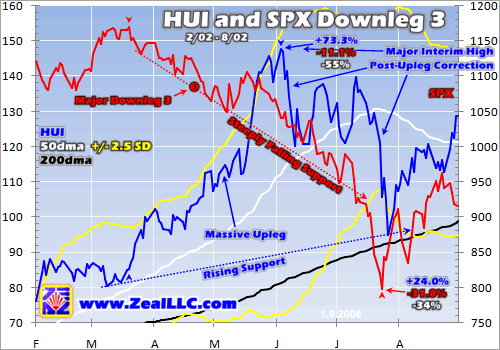|
|
|||||||
|
|
|
|
|
|
|
|
|
|
HUI and Stock Bears 2 Adam Hamilton January 11, 2008 3835 Words
The young new year has not been very happy at all for the stock markets. In the first five trading days of 2008 alone, the S&P 500 bled a brutal 5.3%. This sharp slide nearly doubled the SPX’s losses since early October to 11.2%. Once a general-market correction exceeds 10%, Wall Street gets nervous.
These growing fears have been very apparent on CNBC, which reflects general stock-market sentiment as efficiently as a weathervane reflects prevailing winds. Hosts and guest commentators alike on this premier television network for traders have been universally wringing their hands in disgust. Not only are they worried, but they are lamenting that “all sectors” are being crushed by the “universal selloff”.
But this perception, while understandable given the broad carnage, is incorrect. One sector overlooked by mainstreamers is not only bucking the heavy selling pressure, but thriving despite it. It is the precious-metals miners and explorers, which are represented by their flagship HUI unhedged gold-stock index.
During the very same first five trading days of 2008 when the SPX plunged 5.3%, the HUI soared 10.9%! This is a tremendous gain for any sector in such a short period of time, but it is all the more amazing considering the heavy headwinds of general-stock selling pressure. The gold and silver stocks, of course, were bid up on the record-breaking gold prices and the parallel sharp silver rally.
So if you invest or speculate in PM stocks, 2008 has been a very happy new year indeed! As of the middle of this week, the HUI actually hit a new closing high 52.7% above its latest interim low of mid-August. Over this same five-month period to the day, the SPX was merely dead flat. Clearly the PM-stock sector is marching to the beat of its own drummer, general stocks be damned.
While I am thrilled with my own big gains in this young HUI upleg, as a student of the markets I find it much more satisfying on an academic front. It helps to shatter a pervasive myth that crippled PM-stock investors in 2007. While this particular debilitating myth has been around since this PM-stock bull began way back in November 2000, its popularity swelled last year due to a few isolated events.
The myth states that PM stocks are just another typical general-stock-market sector. Therefore if the stock markets succumb to a sharp selloff or a real ravenous bear, the PM stocks will get dragged down in sympathy. The baby will be thrown out with the bathwater and no sector will escape the hungry bear’s wrath. So if you believe this and you also expect a general-stock bear, you’ll want nothing to do with PM stocks.
The primary spark that resurrected this old fear last year was a sharp selloff in the SPX in late February driven by a Chinese stock-market plunge. The SPX plunged 5.2% in five trading days, very similar to this past week. But the poor HUI fared much worse, amplifying general stock losses by 2.5x for a vicious 13.0% plunge over this same period of time. In another late-July selloff, the HUI fell 1.5x as far as the SPX.
Myopic PM-stock traders witnessed these events and their fears consumed them. If the HUI could take such big hits on this degree of stock selloffs, then surely it would get annihilated in a bear market. They were succumbing to the innate human tendency to take one or two events and extrapolate them out into infinity in the future. They allowed the tyranny of the present to blind them to the precedent of the past.
This reminds me of the irrational way people act after natural disasters and terrorist attacks. Prior to one, no one thinks it can happen to them. But after one, people become utterly convinced another will hit them again soon and so they overreact and overprepare to a ridiculous degree. Even if a tornado hasn’t been witnessed in a particular town for a century, making it a low-probability event, after one hits the local people irrationally fear every dark thundercloud for years to come.
It is not the isolated events that define probabilities, but the events considered within the broad context of history. Sure, there are times when general-stock fears bleed into PM stocks on a short-term basis. PM-stock traders are human too and our emotions are also affected by general-stock-market performance. But to properly game probabilities, these isolated events must be considered from the illuminating perspective of long-term HUI and SPX history.
So if we want to get a better idea of how gold and silver stocks will likely fare in the next general-stock bear, the most logical period to study is the last general-stock bear. Although seldom spoken of today, from March 2000 to October 2002 the SPX lost a breathtaking 49.1% of its value! This makes today’s 11% correction in the SPX seem trivial. Surely if PM stocks were going to succumb to general-stock selling, it would have happened in spades during this wickedly brutal bear.
My charts this week take a look at the HUI’s performance during this last real general-stock bear. The HUI is rendered in blue along with its usual technicals. Then the SPX is superimposed over the top of it in red. The first chart encompasses this entire bear while the latter three zoom in on its three major downlegs where the enormous general-stock selling pressure was far beyond frightening. Surely if the HUI was just another typical sector doomed to follow the stock markets, it would have done so in these downlegs.
But the HUI didn’t mindlessly follow the nasty general-stock bear! Over the exact same span of time to the day that the SPX lost 49.1% of its value, the HUI soared 65.5%! If you wanted to weather the epic 2000-to-2002 stock bear, gold and silver stocks were a fantastic place to do it. We were heavily deployed in PM stocks during this bear and our subscribers made fortunes. It was a fun time to be a contrarian trader!
This comparison, optimized for the general-stock bear, really understates just how awesome the PM stocks performed though. Within the timeline of the broader bear, which carved a secondary bottom in March 2003 before giving up its ghost, a time comparison optimized for the HUI instead is breathtaking. From November 2000 to January 2003, inside the bowels of this bear, the HUI soared 322.1% higher! Wow. And to the very day the SPX lost 37.7% of its value, or almost 4/5ths of its entire bear market.
The HUI rocketed 322% higher during a 49% secular bear in general stocks?!? The prophets of PM-stock doom surely think this is blasphemy. Yet the charts don’t lie. History is history whether we like it or not. If one’s little pet bearish theory doesn’t agree with history, then it is that theory that needs to change to reflect reality. Within a broader context, gold and silver stocks thrive within secular stock bears.
Why? There are three primary reasons. First and most importantly, the metals gold and silver are classic alternative investments. When times get rough and financial assets are buffeted by turbulence, investors naturally seek the safety and stability of alternative investments. So stock bears radically increase investment demand for gold and silver. This was even readily apparent in the brutal 1973-to-1974 stock bear when gold and silver soared (+205% and +241% at best respectively) despite the Dow 30 hemorrhaging a catastrophic 45% of its value.
Second, gold and silver stocks’ primary driver is the prices of gold and silver. When metals prices rise, the metals become more profitable to mine. As the rate of precious-metals’ price increases exceeds the rate of mining cost increases, profits multiply dramatically. Investors and speculators then flock to PM stocks to chase these profits and leverage the underlying gains in gold and silver. Over the long term, PM stock prices follow gold and silver prices regardless of general-stock-market performance.
Third, bear markets are boring and uneventful! Most traders have this perception that bear markets are dominated by sharp and ugly declines. Nothing could be farther from the truth. Bear markets are usually slow and plodding, with only occasional sharp declines. In order to ensure that the most investors lose the most capital possible, bears unfold at a slow pace. They boil the frogs by gradually heating up the water before the investors finally perceive their true peril.
So in sentiment terms, bears keep hope alive as long as possible. This means minimizing sharp down spells. Actually, the biggest daily rallies ever witnessed in stock markets almost all happen during secular bears. Over the first five trading days of 2008, the SPX fell 1.06% on average. Traders tend to think bears are fast and ugly like this. But they aren’t. The 2000-to-2002 SPX bear took 637 trading days to gradually run its course to its staggering 49.1% loss. This yields an average per-day loss of less than 0.08%!
Such average daily losses are so trivial, slow, and boring that traders would scarcely notice. The vast majority of time in bear markets is slow and stealthy declines to keep traders from getting too scared and selling out too soon before the bear has run its course. This is relevant to PM-stock performance because the several-day spells of sharp declines that can sometimes bleed into PM stocks are very rare within bears. The great majority of the time PM stocks can rise within stock bears unimpeded by any selloff headwinds.
Thus gold and silver as classic alternative investments in bear markets, gold and silver stocks following their metals’ prices on balance regardless of general-stock-market performance, and bears being slow and boring work together to yield excellent PM-stock returns during the worst of general-stock times. If you want to multiply your capital during stock bears, look to the precious-metals stocks.
Provocatively, this maxim holds true even in the midst of the very worst individual downlegs. As you can see above, the SPX had three major downlegs in 2001 and 2002. Their average loss was a staggering 26.0% over just 3.4 months each! If such a massive decline started today in the Dow 30, it would lose 3300 points by late April and hit 9400! These downlegs were unbelievably brutal compared to anything witnessed since. If anything could shake the HUI, these were it.
The next three individual major downleg charts follow the same conventions as the bear one above. They show the percentage changes in the HUI and SPX, to the very day, optimized in turn from each’s perspective. Keyed off the red line these percentages show the indexes’ performances over the exact SPX downlegs. Keyed off the blue you can see the indexes’ performances over the best HUI rallies within these general-stock downlegs.
The white number under the percentage changes in the indexes reveals correlation trends. It is a correlation r-square based on the daily correlation of the HUI and SPX over these exact spans of time. While an r-square can’t be negative by definition, minus signs in these charts simply show that the underlying daily correlation squared to reach the r-square happened to be negative. Thus the lower this white number, the more inversely correlated the HUI was with the SPX over a given span of time.
Provocatively unlike the popular myth that says PM stocks will follow the general stocks down in any major selloff, there isn’t one single positive-correlation defined span in all four of these charts. Actual HUI performance during the very worst times of the last secular bear shatters this myth. Once you study the real-world history, the hysteria surrounding the myth looks pretty silly and naïve. Fiction crumbles in the face of facts.
The first major downleg of the 2000-to-2002 SPX bear emerged out of the blue in early 2001. For talking heads like Jim Cramer who think interest-rate cuts are a miraculous stock-market panacea, this wicked downleg started just one month after a big surprise mid-meeting emergency rate cut by the Fed that drove the biggest single-day rally in NASDAQ history, up 14.2%! When a stock bear looms, Fed rate cuts are powerless to impede the necessary and healthy revaluing work the bear must accomplish.
During this downleg, the SPX plunged 19.7% in just over 2 months (equivalent to 2500 Dow 30 points today). This works out to 0.44% per day, 5.5x the average daily decline over the entire bear. Check out the plummeting support line this decline defined, truly frighteningly steep. Yet to the very day of this entire SPX downleg, the HUI actually rose by 8.5%! And if you pick the best HUI performance within this downleg, PM stocks soared 25.5% higher while the SPX bled 4.7%. A scary stock-market selloff sucking in the HUI? Not so you’d notice.
Actually at this stage the HUI was in an accelerating major upleg, the first of its secular bull. Yes it fell for a few days in March in concert with the SPX, but for most of the latter’s nasty downleg the HUI totally ignored it. From time to time a few sharp SPX down days will spook PM-stock traders, but most of the time the HUI simply follows gold and silver. From November 2000 to May 2001, the HUI actually rocketed 112.8% higher in this initial upleg.
Back in early August 2007 I wrote the first iteration of this essay. But since it was summer and many PM-stock traders were sitting on beaches soaking up the sun, the timing wasn’t ideal. I am hoping today’s second iteration released when interest in HUI versus SPX performance is high and gold is soaring will reach a much larger audience. But if you did happen to read my original essay, please be aware that I made one key change here.
Back then I defined the bear’s second major downleg as only running from July 2001 to September 2001. Indeed this was the great majority and steepest part which I was trying to capture. But most people looking at an SPX chart would probably instead consider this second downleg as starting at its preceding interim high in May 2001. So I concede to convention and am now reckoning major downleg two over its broadest possible span.
Using this approach, the SPX plunged a breathtaking 26.4% in less than 4 months during the summer of 2001. In terms of today’s Dow 30 levels, this is the equivalent of a 3400-point loss by early May to put it into perspective. And horrifyingly, the HUI actually fell 5.6% over this same span of time. The myth must be true, as the HUI was dragged into the abyss with the iron chains of general-market selling wrapped around its neck.
But this exception is unique in many ways. First, if I am heavily deployed in stocks and my sector takes a minor 5.6% loss while the general markets hemorrhage 26.4%, I am going to consider myself very blessed and thankful. Obviously with the HUI only sharing in 1/5th of the SPX’s downleg damage, it certainly wasn’t just following the SPX down and amplifying its decline as the popular myth expects.
In reality the HUI had just finished its first major upleg, a stunning 112.8% rally in just 6 months, on the very day the SPX downleg began. After anything more than doubles in just a half year, a correction is surely in order. And indeed the HUI corrected really hard initially right off this top, plunging far faster than the SPX. But as soon as the HUI correction bled off enough of the previous top’s excessive greed, it stabilized. At best within major downleg two, it was up 20.3% while the SPX was down 18.3% over the same period of time.
And in this downleg, like in the first, the HUI did seem to follow the SPX lower at times. In particular note the fast parallel declines in late August and early September 2001. But in early September, the HUI bounced at support and actually soared during the brutal terminal stage of the SPX plunge! The final terminal decline, a bone-shattering 12.7% in just 7 trading days, is when general-stock fears surged to the greatest extremes. Yet defiantly the HUI rose dramatically during these fears, up 15.0% to the day!
This divergence is extraordinarily revealing. During its terminal plunge, the SPX was plummeting 1.8% a day on average, 22.5x the average daily decline of its entire bear! If there was ever a time when PM stocks should get sucked into extreme general-stock fear, this was it. Yet during this gravest of crisis weeks, actually the week after the 9/11 terrorist attacks so you know fears were crazy high, investors flocked to gold as a safe haven. The metal rose 6.5% over these 7 days and the HUI ignored general-stock selling to follow gold.
The worse that things get in the stock markets, the more investors look to gold for refuge. And since the gold market is so small compared to the stock markets, the flood of stock flight capital can drive up its price rapidly. And when gold rises, the PM stocks will follow on balance regardless of general-stock carnage. If you want to thrive in the worst times during general-stock bears, get deployed in precious-metals stocks.
The third major downleg of the 2000-to-2002 SPX bear was the worst by far, down an almost unfathomable 31.8% in just over 4 months. This is the equivalent of losing 4050 of today’s Dow 30 points by May! Jim Cramer would scream himself so hoarse he could never speak again. Larry Kudlow would be so disgusted he’d start campaigning for the democrats. The devastating magnitude of downleg three utterly defies imagination.
Yet despite this horrific general-stock selling, to the very day the SPX fell by nearly 1/3rd the HUI rose 24.0%! And if you take the best HUI performance within this downleg, the HUI was up 73.3% during a span of time when the SPX fell 11.1%. Once again the HUI clearly demonstrated that even during the worst of stock-market times it is not a slave to general-stock performance.
Interestingly, during the first half of this epic downleg the HUI was actually completing its first truly massive upleg of its young bull market. By early June 2002, it had soared 145.4% higher in just over 6 months. Incredibly, fully half of this upleg’s gains occurred after the SPX was already rolling over and accelerating south. General-stock selling was powerless to retard the mushrooming of PM-stock greed near the end of a massive HUI upleg.
And after a 145% gain in a half year, greed was indeed unsustainably extreme and the HUI was definitely due to correct. It corrected in two phases, the first immediately after its new interim high and the second about a month later. This second correction happened to match up pretty well with the terminal plunge of major SPX downleg three. This event is sometimes taken out of context to argue that the HUI will sell off hard whenever fear gets extreme in the general markets. But remember the HUI soared during downleg two’s terminal plunge, so downleg three’s positive correlation is no rule.
Bull to date, the HUI has had seven major corrections averaging 28.3% plunges each in just over 3 months or so. But only one of these sharp corrections happened to coincide with the terminal plunge of a major general-stock downleg. The other six happened anyway without this degree of encouragement from the stock markets. So odds are downleg three’s terminal plunge and the HUI’s second major correction were far more coincidental than causally related. Besides, with the HUI up 24% during a 32% stock-market decline, it certainly wasn’t following the SPX downleg as a whole anyway.
The three worst general-stock downlegs of the 2000-to-2002 bear averaged 26.0% declines over 3.4 months each. To the very days of these entire downlegs, the average HUI performance was a healthy 9.0% gain. To have a sector rise 9% in several months while general stocks fall by a quarter is certainly very impressive in my book. I can’t imagine any seasoned trader not viewing this divergence favorably.
And if we optimize the time comparisons for the best HUI performances within these three downlegs, the results are far better. On average within these worst-of-worst times for general stocks, the HUI soared 39.7% at best! Over these same periods of time, the average SPX loss was a steep 11.4%. The HUI not only held its own during the last bear market in stocks, but it handily bucked the trend and soared to multiply the capital of PM-stock traders throughout the bear.
So if someone has used short samples of time, like mere days or weeks, to convince you that the HUI is doomed in a general-stock selloff, don’t believe it. While the HUI does sometimes parallel heavy SPX selling for a few days, it is fairly rare even within a bear market. Whether general stocks are rising, drifting, or falling, the precious-metals stocks follow gold and silver prices. This truly alternative sector could not care less about the general stock markets’ trend.
At Zeal we were among the early PM-stock investors and speculators during the 2000-to-2002 bear. I can tell you from firsthand experience how much fun it was to be in a thriving sector when the stock markets burned around us. Thanks to this strong HUI history, I don’t think there is any reason for PM-stock traders to fear a general-stock selloff at all. On the contrary, weak general stocks ramp up gold investment demand which drives up gold prices. And the PM stocks eventually follow.
And today it looks like the PM stocks are once again fairly early on in a massive new upleg. We have been aggressively buying on weakness and it is not too late to add more positions. Odds are the HUI has much higher to run yet before its next major interim high is reached. To mirror our latest real-world PM-stock trades, subscribe today to our acclaimed monthly newsletter. You can share in the very profitable fruits of our long years of research as hardcore students of the markets.
The bottom line is the perpetual myth about PM stocks being just another highly-positively-correlated stock-market sector has no meaningful historical basis. PM stocks are unique, a classic alternative sector that marches to the beat of its own drummer regardless of general-stock-market fortunes. On balance, PM stocks always eventually follow gold and silver prices whether the SPX is rising, flat, or falling.
While it is true PM stocks occasionally get sucked into a sharp stock-market selloff over a few days, this is fairly rare. Even during the worst downlegs within the worst secular bears, PM stocks have no problem rallying on balance if gold and silver are strong. In light of historical precedent, the odds are high that PM stocks will continue this strong inverse performance relative to general stocks during the next sharp SPX selloff or even full-blown bear.
Adam Hamilton, CPA January 11, 2008 Subscribe |
|||||||
|
|
|
|
|
|
|
|
|
|
|
|
|
|
|
|||




